
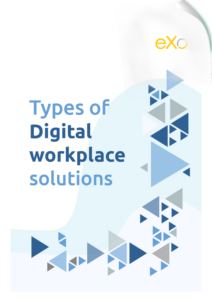

FREE WHITE PAPER
Digital workplace is a buzzword these days. Actually different people use it to mean different things. So what is a digital workplace?
A digital workplace is an integrated, virtual ecosystem of technology, platforms, and tools that provides employees with everything they need to do their jobs effectively, regardless of their physical location. It’s the modern, virtual equivalent of a physical office, designed to streamline communication, collaboration, and productivity.
In the post-pandemic era, the traditional office model has been largely replaced by hybrid and remote work. This shift has made digital workplace solutions essential for businesses to maintain continuity, foster a cohesive culture, and support a distributed workforce. A digital workplace isn’t a single product but a strategic approach to integrating various technologies to create a unified and efficient work environment.
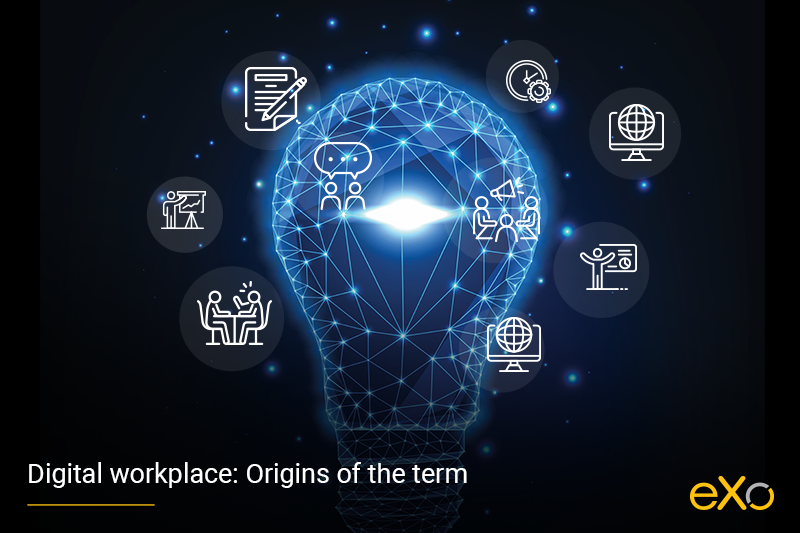
The traditional office, with its cubicles, water coolers, and paper-filled filing cabinets, is undergoing a profound transformation. This change was accelerated by global shifts towards remote and hybrid work models, but its roots are in a deeper, more permanent evolution: the rise of the digital workplace.
This article serves as a definitive guide to understanding what a digital workplace is, why it’s critical for business success, the different types of solutions available, and how to choose the right one.
A quick look at Google trends shows the increasing interest in digital workplace solutions over the last couple of years. The term has started to go mainstream thanks to publications and books by industry experts such as Paul Miller (CEO of Digital Workplace Group) and Jane Mcconnell (a digital expert and researcher).
Miller popularised the term through his book “digital workplace: How technology is liberating work” published in 2012. The book is based on the premise that the physical office will slowly be less central following innovations in technology such as mobile devices, telecommunications services, social media and more.
The digital workplace is defined in the first chapter as “the technology-enabled space where work happens – the virtual, digital equivalent of the physical workplace”. Miller further explained that work shouldn’t be about the ‘where’ anymore, rather than the ‘how’. Employees nowadays have the tools to perform their jobs from any location and from any device (depending on the nature of the job of course) so they are not restricted to a physical location. This flexibility helps increase engagement and recruit better qualified individuals.
“If it’s no longer where you work but how you work, then this shift brings control, influence, empowerment and autonomy, to each of us” ~ Paul Miller
Jane Mcconnell, in her quest to stress the importance of the intranet and make it more appealing to top management, led a research study for the “digital workplace trends report” previously known as “the intranet trends report” – you see the growing importance of the term already.
In a blog post published in 2009, Mcconnell led a brainstorming session with over 300 members from an intranet group she managed on LinkedIn to replace ‘intranet’ with a new term. The session resulted in a number of terms ranging from the obvious ‘web office’, ‘online office’ and ‘web workplace’ to the more sophisticated “company information, news and collaboration portal’ and ‘my collective and personal workplace’.
Bizarrely enough, the list didn’t contain the term ‘digital workplace’. Instead, Mcconnell favoured ‘web workplace’ as it conveys the importance of providing solutions for on-site as well as remote and mobile teams and that the term is easily remembered and identifiable through its initials ‘WW’. The digital workplace won the naming rights and became the de facto standard.
However, in an article published earlier this year, Mcconnell stated that ‘web workplace’ – even though it is not in use today – is more comprehensive and accurate than ‘digital workplace’ and doesn’t sound technical, which resonates well with HR and communication specialists.
The digital workplace is used to mean different things by different people. As with any pithy concept, the Internet offers a number of definitions. Ephraim Freed from The Digital Workplace Group (DWG), wrote a comprehensive blog post on different definitions of digital workplace, counting at least eight of them. It is worth a read, especially if you are interested in the concept’s evolution or the philosophical implications of it. Below are the definitions I found interesting:
In 2019, I wrote an article about the history of the intranet from the early years all the way up to … you guessed it … the digital workplace. Although, as I mentioned earlier, defining ‘the digital workplace’ as an evolution of the intranet is a bit limited, it is necessary to associate an emerging term with already established concepts so people can relate. This idea was the foundation of the concentric eggs diagram of the digital workplace by DWG. The diagram has three layers.
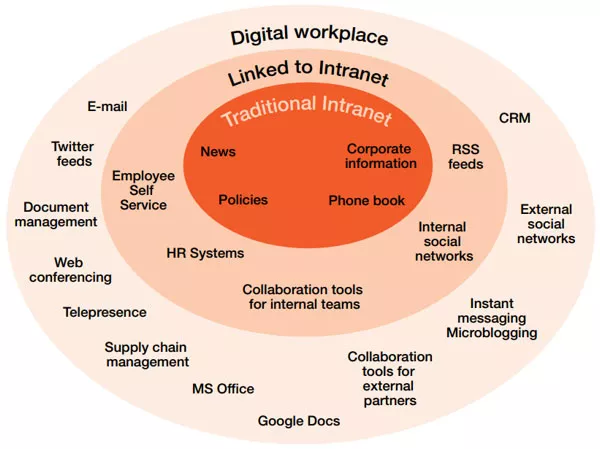
Created nearly 10 years ago, the diagram is a bit outdated since it is overly centered around technology rather than people and the employee experience. However, its close ties to already established terms like the intranet make it comprehensive and to the point.
With early definitions of the term, the digital workplace was portrayed as an ecosystem and environment of the different tools people use in the workplace. This was the case with Gartner’s definition, initially communicated in 2014: “an ongoing, deliberate approach to delivering a more consumer-like computing environment that is better able to facilitate innovative and flexible working practices”. Nothing is wrong with this definition.
However, if you take a look at Gartner’s glossary, you will find a slightly different one: “The Digital Workplace enables new, more effective ways of working; raises employee engagement and agility; and exploits consumer-oriented styles and technologies.” The key terms added, such as employee engagement, agility and consumer-orientated show the shift towards making the digital workplace more tailored to employees’ needs and more appealing to non-technical staff and decision makers.
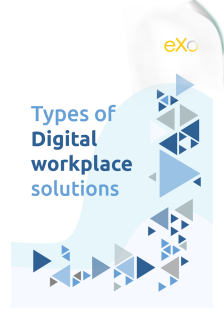
Types of Digital workplace solutions
Digital workplace is a buzzword these days. Actually different people use it to mean different things. So what is a digital workplace?



Digital workplace is a buzzword these days. Actually different people use it to mean different things. So what is a digital workplace?
The digital workplace is no longer just a “nice-to-have.” In 2025, it has become a strategic necessity for every organization—whether you’re a small business or a global enterprise. Work has changed, and so have employee expectations. Let’s break down why the digital workplace is more important than ever this year.
The right technology makes work smoother, faster, and far less frustrating. A well-designed digital workplace reduces friction—like constantly switching apps, searching for lost files, or dealing with clunky systems. According to The Guardian, poor tools can quickly drain morale and lead to disengagement, while good ones boost both productivity and satisfaction. In short: happy employees are productive employees.
Whether people are in the office, at home, or on the go, work is digital by default. As LumApps points out, even employees who come into the office rely on the same online platforms to collaborate with remote colleagues. Gartner estimates that by 2025, nearly one-third of all employees will work remotely. Without a solid digital workplace, maintaining culture, cohesion, and performance across dispersed teams becomes nearly impossible.
Today’s workforce—especially digital natives—won’t tolerate outdated, clunky systems. Employees expect the same smooth, user-friendly experience they get from their personal apps. If companies fail to provide that, frustration builds, engagement drops, and turnover increases. A modern digital workplace isn’t just about efficiency—it’s about meeting the expectations of the people who power your business.
Departments often operate in isolation, each with their own tools and workflows. A strong digital workplace acts as a central nervous system, connecting people, data, and applications. This breaks down silos, allowing seamless collaboration across teams, locations, and time zones. Features like instant messaging, shared drives, and video conferencing make teamwork effortless and inclusive.
Beyond communication and collaboration, the digital workplace also provides valuable analytics and insights. Platforms like Microsoft Viva, for example, give leaders visibility into how teams are working and where improvements can be made. These insights help organizations foster healthier work patterns, prevent burnout, and support employee wellbeing—crucial in a world where digital overload is real.
A unified digital workplace saves employees countless hours wasted on app-switching and document hunting. A 2024 Gartner report found that the average employee uses 11 different apps daily—a clear source of “digital friction.” Streamlined platforms reduce this complexity, freeing people to focus on high-value work and innovation instead of admin.
Culture doesn’t stop at the office door. A modern digital workplace helps employees feel connected, recognized, and aligned with the company’s mission—no matter where they are. Recognition tools, social feeds, and community spaces foster a sense of belonging and engagement, which in turn supports retention and loyalty.
Markets shift, technologies evolve, and employee needs change quickly. A strong digital workplace gives organizations the agility to adapt—whether that means embracing hybrid work, scaling rapidly, or responding to new challenges. It also makes companies more attractive to top talent, who increasingly prioritize flexibility and work-life balance.
Finally, stability matters. Vendor changes can significantly impact organizations. A recent example is Workplace by Meta, which officially ended service on August 31, 2025, with read-only access before deletion in 2026 (The Wall Street Journal). This sunsetting has forced many companies to re-platform, reminding leaders that choosing a reliable and future-proof digital workplace is critical for business continuity.
👉 In short, the digital workplace is the foundation of modern work. It improves productivity, fosters engagement, connects people, and ensures organizations can thrive in a hybrid, fast-changing world. In 2025, investing in the right digital workplace is not optional—it’s the key to staying competitive.
The digital workplace is not a single tool but an ecosystem of interconnected platforms. Each category serves a different purpose, and together they shape how employees communicate, collaborate, and get work done. Understanding these categories helps organizations choose the right mix for their people and business needs.
These platforms have evolved from traditional company intranets into dynamic employee experience hubs. They act as the digital front door to the workplace, bringing together news, resources, and personalized content in one central place.
Modern intranets focus on:
A 2024 Gallup study found that employees who feel connected to their organization through communication and culture are 3.8 times more likely to be engaged at work (Gallup, 2024).
These platforms are built to facilitate real-time interaction. They center around conversations, teamwork, and shared workflows. Instead of endless email chains, collaboration hubs provide a structured space for chat, channels, meetings, and integrated workflows.
Key features include:
Research from McKinsey shows that companies using effective collaboration technologies can increase productivity by up to 30% through faster information flow and reduced silos (McKinsey, 2023).
These platforms are the backbone of daily work. They include core applications like documents, spreadsheets, presentations, storage, and email — now enhanced with AI and cloud-native features.
What makes modern productivity suites powerful today is:
According to a Deloitte 2024 report, organizations that leverage AI-powered productivity tools experience 20–25% faster decision-making cycles (Deloitte, 2024).
Information overload is a major challenge in digital work. Knowledge platforms solve this by enabling employees to capture, organize, and find information quickly.
Modern capabilities include:
Gartner predicts that by 2027, 50% of knowledge workers will rely on AI-powered search daily to navigate the complexity of digital workplaces (Gartner, 2024).
These platforms provide structure for tasks, projects, goals, and processes. They connect day-to-day activities with larger organizational objectives, ensuring alignment and accountability.
Features often include:
Harvard Business Review research shows that organizations using structured work orchestration tools see a 33% improvement in project success rates compared to those relying on informal methods (HBR, 2023).
Finally, some platforms aim to bring it all together — combining intranet, collaboration, productivity, knowledge, and orchestration into a single, unified environment. These platforms reduce fragmentation, simplify the employee experience, and offer leadership better visibility into how work gets done.
The most effective digital workplaces are not just collections of apps. They are strategic ecosystems designed to support both productivity and employee well-being. As the workplace continues to evolve in 2025 and beyond, organizations that integrate these tools thoughtfully will be best positioned to thrive.

The Complete Guide to
Employee Engagement
Discover our in-depth analysis of the concept of employee engagement, its roots, and ways to improve it significantly



Discover our in-depth analysis of the concept of employee engagement, its roots, and ways to improve it significantly
A well-designed digital workplace is more than a collection of apps — it’s the foundation of how people connect, collaborate, and thrive in modern organizations. When implemented effectively, it brings both immediate productivity gains and long-term cultural and strategic benefits.
One of the biggest challenges employees face today is the constant switching between multiple apps and tools. Studies show that workers toggle between applications more than 1,200 times per day, losing focus and wasting time (Harvard Business Review, 2023). Digital workplace software reduces this friction by providing unified navigation, integrated search, and streamlined workflows, allowing employees to stay in the flow of work.
Clear and targeted communication is essential in hybrid and distributed environments. Modern digital workplaces make it possible to deliver role-based news, personalized updates, and critical announcements directly to the right audiences. This ensures employees aren’t overwhelmed with irrelevant information, while still staying informed and aligned with organizational priorities.
According to Deloitte, companies with effective digital communication strategies are 23% more likely to report higher employee satisfaction and alignment (Deloitte, 2024).
Collaboration has moved far beyond email threads. Digital workplace platforms create shared spaces for projects, real-time document co-authoring, chat, video meetings, and events. This makes teamwork seamless across departments, time zones, and even external partners.
Research from McKinsey indicates that organizations leveraging digital collaboration tools can see a 20–30% improvement in team productivity (McKinsey, 2023).
When knowledge is scattered across emails and personal drives, it’s easily lost — especially when employees leave. A digital workplace provides a structured knowledge base with pages, discussions, wikis, and even micro-learning modules. This ensures that expertise stays within the company and can be easily accessed by new and existing employees alike.
Gartner predicts that by 2027, half of all knowledge workers will rely daily on AI-powered knowledge discovery tools to navigate workplace complexity (Gartner, 2024).
Modern platforms don’t just enable work — they also measure how work happens. Analytics dashboards track content reach, engagement, and even “digital friction” (bottlenecks or inefficiencies employees face). This gives leaders the insights needed to improve processes, reduce burnout, and design a healthier digital employee experience.
A Forrester 2024 report found that organizations investing in DEX measurement tools saw a 17% reduction in employee turnover (Forrester, 2024).
As more work moves online, ensuring security and compliance is non-negotiable. Digital workplace platforms offer role-based access control (RBAC), audit trails, and compliance support to meet industry standards. This safeguards sensitive information while ensuring employees only see what is relevant to their role.
Cybersecurity Ventures estimates that human error remains the root cause of over 80% of data breaches, making well-governed platforms a critical investment (Cybersecurity Ventures, 2024).
Beyond productivity, digital workplaces also shape company culture. By creating spaces for recognition, feedback, and community engagement, they help employees feel connected — whether they’re working from an office, at home, or across the globe. This sense of belonging directly impacts retention and engagement.
Gallup reports that employees who feel connected to their company culture are 3.7 times more likely to be engaged at work (Gallup, 2024).
For new hires, digital workplaces act as a one-stop portal for accessing company resources, colleagues, and learning materials. This accelerates onboarding and helps employees become productive faster. At the same time, organizations benefit from increased agility — being able to respond quickly to change, scale communication, and realign teams when priorities shift.
A PwC study found that agile organizations are twice as likely to achieve top-quartile financial performance compared to peers with slower digital adoption (PwC, 2024).
Finally, digital workplaces help organizations remain resilient in the face of market or vendor shifts. Choosing platforms with clear roadmaps, interoperability, and openness protects businesses against sudden disruptions — such as discontinued tools or platform volatility. This ensures continuity and long-term stability in how work gets done.
👉 In short, digital workplace software is no longer a “nice-to-have.” It’s the infrastructure of modern work, shaping not only how employees perform tasks but also how they experience their jobs, stay engaged, and contribute to organizational success.
Choosing the right digital workplace platform can feel overwhelming. With so many tools promising productivity gains, seamless collaboration, or better employee engagement, it’s easy to get lost in the buzzwords. The reality is simple: the best platform is the one that integrates smoothly into daily work, reduces friction, and grows with your organization.
Here are the key features to look for in 2025 — based on the latest workplace research and evolving employee needs.
Artificial Intelligence has shifted from being a “nice add-on” to a core capability. Modern platforms now embed AI directly into workflows, offering:
According to PwC, companies adopting AI-enhanced productivity tools are seeing productivity gains of up to 40% in knowledge-based roles (PwC, 2024).
A digital workplace should feel like a personalized home base, not just another app. Features like role-based targeting, customizable dashboards, and personalized news feeds ensure employees see what’s most relevant to them — instead of wading through clutter.
Research from Gartner shows that personalized digital experiences can increase employee engagement by 27% (Gartner, 2024).
A workplace platform must integrate seamlessly with existing business tools, whether HR systems, CRM platforms, or project management apps. This avoids creating yet another silo and instead provides a single pane of glass where employees can access all apps through one secure login.
McKinsey highlights that organizations with fully integrated systems spend 25% less time switching between applications, freeing employees to focus on higher-value work (McKinsey, 2023).
Knowledge is only valuable if it can be found and shared. Modern digital workplace platforms include:
By 2027, Gartner predicts half of all employees will rely daily on AI-driven search and summarization tools to navigate complex digital environments (Gartner, 2024).
True collaboration isn’t just messaging. It’s about having a fabric of connected tools: shared spaces, real-time chat, meetings, calendars, tasks, and events — all in context. This reduces the fragmentation caused by juggling multiple platforms.
Forrester research found that companies adopting an integrated collaboration approach see project delivery times improve by 22% compared to those using disconnected tools (Forrester, 2024).
In 2025, not every employee is at a desk. Frontline and mobile workers need targeted communication, easy publishing tools, and read receipts to stay in the loop without being overwhelmed. Mobile-first design ensures the workplace platform truly supports everyone, not just office-based staff.
A study by Accenture revealed that organizations prioritizing mobile experiences for frontline employees achieve 21% higher retention rates (Accenture, 2024).
Beyond enabling work, platforms should measure how work happens. Modern analytics include:
This data-driven insight helps leaders refine processes and improve employee experience. Forrester reports that organizations tracking DEX see a 15% reduction in digital fatigue (Forrester, 2024).
With more sensitive work moving online, security and governance are non-negotiable. Look for:
Cybersecurity Ventures estimates that strong governance could prevent up to 80% of breaches caused by human error (Cybersecurity Ventures, 2024).
Organizations have different needs when it comes to deployment. In 2025, leading platforms offer cloud, on-premise, or hybrid options. Open architectures and extensibility are also key, giving organizations sovereignty over their data and flexibility to customize.
The digital workplace is only as reliable as the vendor behind it. Look for:
Gartner warns that vendor volatility — such as discontinued features or sunsetted products — is one of the biggest risks to long-term digital workplace success (Gartner, 2024).
✅ In summary: The best digital workplace platform in 2025 is intelligent, unified, integrated, mobile-friendly, secure, and future-proof. It should reduce friction, empower employees, and evolve with your organization — not hold it back.
Digital workplace platforms are no longer optional — they’re the backbone of modern work. From keeping employees aligned to ensuring knowledge doesn’t get lost, the best platforms solve real-world challenges organizations face every day. Here are the top use cases in 2025:
A central digital hub gives employees a single source of truth for news, alerts, and resources. This reduces digital friction, prevents information overload, and improves alignment across dispersed teams. Research highlights that organizations with strong internal communication are 3.5 times more likely to outperform peers (The Guardian, 2024).
Searchable knowledge bases and “how-to” guides help employees resolve issues quickly, reducing time-to-resolution and ensuring standard operating procedures (SOPs) are followed. The Digital Workplace Group (DWG) emphasizes that the digital workplace should be the first place people go to get work done (Reworked, 2024).
Not all employees sit at a desk. Retail, healthcare, and field service workers rely on mobile-friendly, targeted communications to stay connected without overwhelming them. Companies prioritizing frontline enablement report 21% higher retention among non-desk employees (Accenture, 2024).
Analytics now provide privacy-safe insights into digital behaviors, such as meeting overload, after-hours work, and collaboration bottlenecks. Leaders can act on this data to design healthier work patterns. Microsoft research shows that reducing “always-on” culture can cut burnout risk by up to 30% (Microsoft Learn, 2024).
With some platforms sunsetting (e.g., Workplace by Meta shut down in August 2025), organizations are moving toward sustainable, future-proof platforms with clear roadmaps. Proactive transitions prevent costly disruptions when services enter read-only or deletion phases (Meta, 2025).
So, how do you know what to look for in a modern digital workplace? Let’s break it down.
When drafting your RFP or evaluation criteria, start with the essentials. A strong digital workplace today should include:
While not every organization needs them on day one, these features can dramatically improve employee engagement and inclusivity:
The digital workplace isn’t static—it evolves. According to recent research:
Feedback across public reviews often echoes the same themes:
Selecting a digital workplace in 2025 is about much more than buying software—it’s a strategic decision that shapes how your people work, connect, and thrive.
Here’s the checklist to keep in mind:
Ultimately, the best digital workplace is not just a set of tools—it’s the foundation of your company’s digital culture and agility. In a competitive landscape where talent retention and productivity are paramount, investing in the right platform is not optional. It’s essential for long-term success.
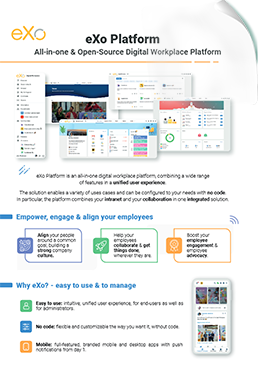
eXo Platform : The Open-Source
Digital Workplace Platform
Download the eXo Platform Datasheet and discover all the features and benefits
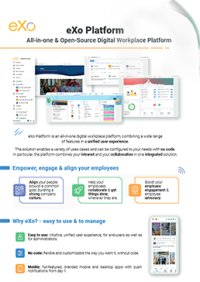

Download the eXo Platform Datasheet and discover all the features and benefits
You will find here Frequently Asked Questions about digital workplace with all the answers in one place.
The digital workplace is an overarching concept. It includes everything—from the software employees use to chat and share documents, to the platforms that integrate those tools, to the cultural processes that make work effective.
The digital workplace is no longer just a “nice-to-have” — it has become a strategic necessity for organizations of all sizes. Work is hybrid, distributed, and fast-changing, and employee expectations are higher than ever. A modern digital workplace ensures productivity, engagement, and resilience.
Here are the main reasons why it matters today:
➝ See the full explanation of why the digital workplace matters
The digital workplace isn’t a single app but an ecosystem of platforms that together support communication, collaboration, and productivity. Each category plays a unique role in shaping the employee experience.
Main categories include:
A well-designed digital workplace goes beyond apps — it’s the foundation of modern work. It improves productivity, culture, and resilience while reducing friction for employees.
Key benefits include:
( Your e-mail address will not be published)
I am a Digital Marketing specialist specialized in SEO at eXo Platform. Passionate about new technologies and Digital Marketing. With 10 years' experience, I support companies in their digital communication strategies and implement the tools necessary for their success. My approach combines the use of different traffic acquisition levers and an optimization of the user experience to convert visitors into customers. After various digital experiences in communication agencies as well as in B2B company, I have a wide range of skills and I am able to manage the digital marketing strategy of small and medium-sized companies.
Truly a lot of wonderful info.
Truly a lot of wonderful info.
Cheers, I enjoy this.
Cheers, I enuoy this.
Nichely put, Cheers!
Great info. Many thanks.
Great info. Many thanks.
Seriously a lot of helpful advice!
Best Essay writing
Nice post !